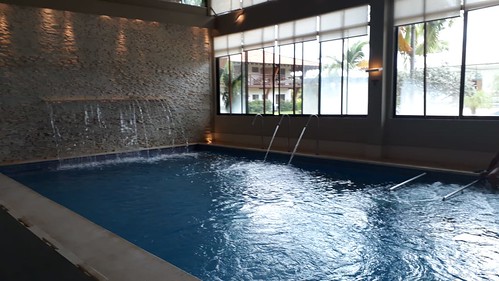Tion field was estimated for every single person image such that tissue
Tion field was estimated for each individual image such that tissue probability maps for every tissue class were finest aligned. The segmented photos were imported (only for GM and WM) each in native space and DARTEL space. The segmented photos (only GM and WM) were then iteratively registered by means of a rapidly diffeomorphic registration algorithm47 (DARTEL) to warp the GM and WM partitions into a studyspecific template space representative of your average of all study subjects. This procedure made a template image for the group of individuals and also estimated the nonlinear deformation flow fields that most effective aligned individual photos together. This template image was then transformed to MNI stereotactic space (two 2 two mm) applying affine and nonlinear spatial transformations to create normalized, Jacobianscaled (grey matter amount preserved, i.e.) GM photos for each participant. These photos were also simultaneously smoothed with an isotropic Gaussian kernel with FWHM of 0 mm. Note that these final smoothed images represent absolute amount of nearby GM at each and every voxel inside the brain48,49. These smoothed normalized GM MK-8745 web segments were then entered into a statistical model to conduct voxelwise statistical tests and map significant effects. The statistical analysis was carried out by fitting a GLM for the information. We included age, age2 (to model quadratic effects of age), handedness, and gender as nuisance covariates50,5. Considering the fact that total intracranial volume (TIV) was entered as a global for proportional scaling, it was not integrated within the style matrix as a regressor. Repeating the exact same evaluation by getting into TIV values not as globals but as covariates developed related final results. Despite the fact that no all round grand mean scaling was applied, we applied worldwide normalization by entering TIV values as globals (as encouraged by Ridgway et al.52) in proportional scaling, which identifies precise regional alterations which are not confounded by worldwide differences. Four separate regression models have been designed for each situation containing moral judgment score, age, age2, handedness, and gender as predictors and GMV because the dependent measure in each model. Two contrasts were made for every single model that regressed neighborhood GMV around the moral judgment scores, one tracking good association, even though the other negative: (a) Optimistic ([0, ]; greater GMV connected with enhanced moral condemnation) and (b) Negative ([0, ]; higher GMV linked with lowered moral condemnation). Importantly, the secondlevel analyses were restricted only to voxels contained in the inclusive mask derived in the ToM localizer task (see Fig. ). Note that choice of voxels integrated within the mask was independent in the information used within the VBM analysis circumventing any circularity53. Offered recent criticism of parametric clusterlevel inference54,55, considerable clusters were formed PubMed ID:https://www.ncbi.nlm.nih.gov/pubmed/20118028 by employing the thresholdfree cluster enhancement (TFCE) strategy (as implemented in TFCE toolbox (r95): http:dbm.neuro.unijena.detfce). The TFCE is really a clusterbased thresholding approach that circumvents the issue of picking out an arbitrary cluster forming threshold (e.g p 0.00 (uncorrected) and k 0) by taking a raw statistics image and generating an output image in which the voxelwise values  represent the quantity of clusterlike local spatial support56. This also makes the TFCE inference fairly robust to nonstationarity in the information beneath varying smoothness levels, degrees of freedom and signal to noise ratios57,58. The TFCE image is then turned into voxel.
represent the quantity of clusterlike local spatial support56. This also makes the TFCE inference fairly robust to nonstationarity in the information beneath varying smoothness levels, degrees of freedom and signal to noise ratios57,58. The TFCE image is then turned into voxel.